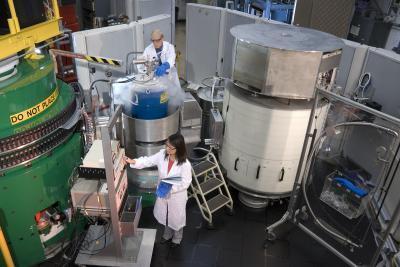These superconductors will be able, in the future, to provide energy and environmental benefits due to their ability to significantly increase the efficiency of electricity transmission in electronic components or to store excess electricity during hours when consumption is low for later use

In initial studies of a new family of high-temperature superconductors discovered earlier this year, researchers from the National Institute of Standards and Technology (NIST) revealed that iron-based superconductors have rare magnetic properties shared by long-known superconducting materials from the copper oxide family.
These superconductors will be able, in the future, to provide energy and environmental benefits due to their ability to significantly increase the efficiency of electricity transmission in electronic components or to store excess electricity during hours when consumption is low for later use. "Although we still do not fully understand the relationship between magnetism and superconductivity in copper-oxide-based materials," explains the lead researcher, "our measurements show that the new iron-based materials contain the characteristic and essential property that links magnetism to superconductivity." The importance of magnetism for superconductors at an unusual high temperature since magnetism severely interferes with common superconductors at low temperature. "Even a negligible amount of magnetic "impurities" in superconductors at low temperature can severely damage the properties of the conductor," says the researcher.
In contrast, copper-oxide-based superconductors, discovered in 1986, are able to work efficiently even in the presence of magnetic fields at high temperatures. The most efficient superconductor of this type conducts electricity without any resistance when it is cooled to "transition temperatures" of minus 133 degrees Celsius using simple and cheap liquid nitrogen capable of cooling down to a temperature of minus 196 degrees Celsius. Japanese researchers discovered earlier this year that a new type of iron-based superconducting material also had higher transition temperatures than conventional superconductors. This discovery pushed physicists and materials science researchers into a renewed scientific revolution, similar to the excitement that existed when the first superconductors appeared about twenty years ago. An earlier study of these superconductors revealed that they consist of magnetically active copper-oxide layers, separated by layers of non-magnetic materials. Through this doping, i.e. intentional contamination of the active material by adding additional factors to the non-magnetic layers of the originally isolated material, researchers can adjust the magnetism to obtain electrical conduction and hence - superconductivity.
The team of scientists examining the iron-based superconductors took advantage of a facility that allows the use of powerful beams of neutral particles (neutrons) to test the atomic structure and magnetic behavior of the new material. When the neutrons were "irradiated" to the iron-based sample provided by scientists from Beijing, the researchers discovered a magnetism similar to that found in copper oxide-based superconductors, that is, layers of magnetic moments - like a large collection of magnetic "rods" - separated by layers of non-magnetic material. The lead researcher claims that the structural similarity between these two types of superconductors cannot be a coincidence. One of the exciting aspects of these new superconductors is the fact that they belong to an extensive group of materials in which a large variety of chemical alternatives are possible. This versatility is already opening new avenues of research for understanding the origin of superconductivity, and may also, in the near future, enable the commercial design of electronic devices.

7 תגובות
If I'm not mistaken, gold is the best conductor of electricity
Michael thanks.
It is indeed written that due to the small conversion losses, the efficiency is about 95 percent, but this does not take into account the energy required for cooling. I still need to understand why this is worthwhile despite the energy spent on cooling. I asked the exact same question in Yael Petar's article "For the first time: a car powered by a superconductor".
lion,
For example:
http://en.wikipedia.org/wiki/Superconducting_magnetic_energy_storage
How do superconductors store excess electricity?
to 2. The figure minus 133 refers to a previous discovery
of different types of superconductors and minus 196 is temperature
the boiling of nitrogen; The question at what temperature does it become
The text on which this is an article for a conductor is left without
Answer.
From the second paragraph of the article -
"The most efficient superconductor of this type conducts electricity without any resistance when cooled to "transition temperatures" of minus 133 degrees Celsius using simple and cheap liquid nitrogen capable of cooling down to a temperature of minus 196 degrees Celsius"
Is that what you were looking for?
Why doesn't the main figure appear in the article, the temp.?